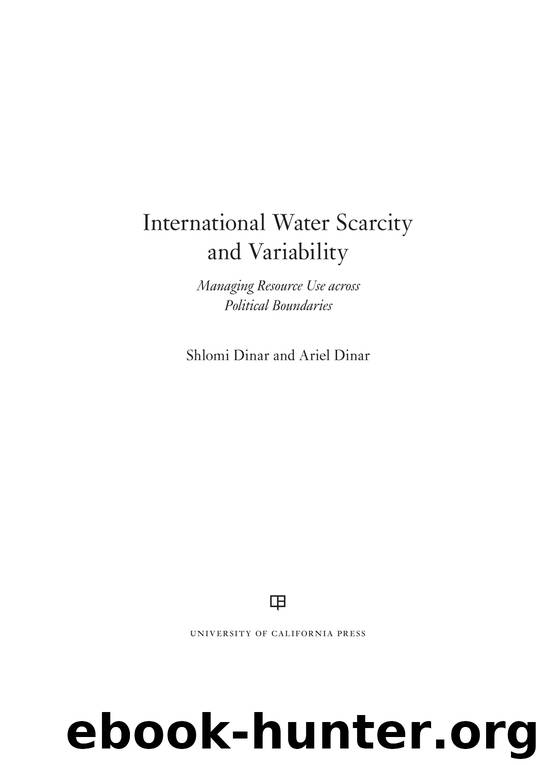International Water Scarcity and Variability by Dinar Shlomi; Dinar Ariel;

Author:Dinar, Shlomi; Dinar, Ariel;
Language: eng
Format: epub
Publisher: University of California Press
The Case of the Columbia River
The Columbia River is shared between upstream Canada and the downstream United States. The latter is mightier than the former in aggregate-power terms. While the 1961 Columbia River agreement14 has benefitted both riparians, the negotiation process and a reading of the treaty point to Canada’s use of its superior upstream position to extract concessions from the U.S.
Specifically, post-war America was booming in the 1950s and the need for electricity was increasing considerably.15 (Flood control was another priority for the U.S.) Upstream Canada likewise considered its increasing power demands and economic growth (LeMarquand 1977, 56). Cooperation would therefore provide benefits to both countries, given their scarcity in energy and flood-control benefits.
Interestingly, Canada was at first reluctant to go ahead with any projects unless it was assured of receiving some compensation for the unrealized benefits it was to send downstream to the U.S. (Lepawsky 1963, 542; Krutilla 1966, 10; LeMarquand 1976, 886; Barrett 1994, 22; Housen-Couriel 1994, 16; Giordano 2003a, 371). Barrett (1994) notes that the U.S. believed that Canada would want to develop the Columbia River on its side of the border anyway, and so felt that it did not need to compensate Canada for constructing the project. When Canada threatened to construct an alternative project on a different river, which would provide the U.S. with no benefits, the U.S. heeded the threat as a credible one, and Canada was able to secure a more attractive deal (22).
The agreement stipulated that Canada construct the dams which would provide the improved stream flow and regulation and thereby increased hydropower generation (and flood control) in the U.S. Half of the downstream power benefits produced in the U.S., and created by the enhanced water flow, were to be provided to Canada. The Canadian entitlement was considered surplus energy, at the time, and was sold to the U.S.
Krutilla (1966) likewise notes that the treaty cannot be considered an isolated affair. In addition to the compensation provided to Canada, issue linkage was likewise affected. According to Krutilla, the Columbia River system was an arena in which the U.S. could make an attractive arrangement in exchange for concessions perhaps involving North American continental defense or perhaps other areas in which the vital interests of the U.S. were at stake (96).
In all, Canada’s bargaining position was strengthened given its upstream position, where the majority of infrastructure per the Columbia River agreement was to be built. Consequently, it could extract particular concessions from the downstream riparian and shape the final outcome. At the end, side payments and benefit-sharing projects (hydropower and flood-control facilities) incentivized cooperation.
Download
This site does not store any files on its server. We only index and link to content provided by other sites. Please contact the content providers to delete copyright contents if any and email us, we'll remove relevant links or contents immediately.
International Integration of the Brazilian Economy by Elias C. Grivoyannis(75540)
The Radium Girls by Kate Moore(11627)
Turbulence by E. J. Noyes(7708)
Nudge - Improving Decisions about Health, Wealth, and Happiness by Thaler Sunstein(7255)
The Black Swan by Nassim Nicholas Taleb(6775)
Rich Dad Poor Dad by Robert T. Kiyosaki(6185)
Pioneering Portfolio Management by David F. Swensen(6083)
Man-made Catastrophes and Risk Information Concealment by Dmitry Chernov & Didier Sornette(5659)
Zero to One by Peter Thiel(5498)
Secrecy World by Jake Bernstein(4394)
Millionaire: The Philanderer, Gambler, and Duelist Who Invented Modern Finance by Janet Gleeson(4108)
The Age of Surveillance Capitalism by Shoshana Zuboff(3991)
Skin in the Game by Nassim Nicholas Taleb(3973)
The Money Culture by Michael Lewis(3851)
Bullshit Jobs by David Graeber(3837)
Skin in the Game: Hidden Asymmetries in Daily Life by Nassim Nicholas Taleb(3731)
The Dhandho Investor by Mohnish Pabrai(3566)
The Wisdom of Finance by Mihir Desai(3531)
Blockchain Basics by Daniel Drescher(3333)
